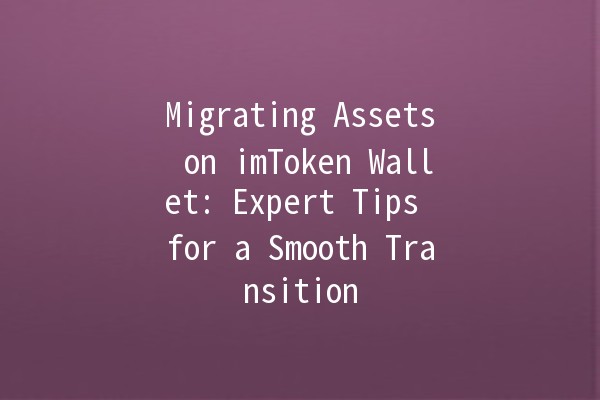The world of cryptocurrencies and digital wallets has grown rapidly, making it essential for users to manage their assets efficiently. One popular wallet, imToken, is widely used for storing a variety of digital assets. However, asset migration within the imToken wallet can be a daunting task for many users. This article will provide practical advice and techniques to ensure that your asset migration process is seamless and efficient.
Before diving into the tips for effective asset migration, it’s essential to understand what asset migration is in the context of the imToken wallet. Asset migration entails transferring your digital assets from one wallet to another or even from one blockchain to another. This might be necessary for several reasons, such as security concerns, improving user experience, or accessing new features.
Enhanced Security: Moving assets away from a wallet with security vulnerabilities can protect your investments.
Access to New Features: Certain wallets offer features that may enhance your trading or holding experience.
Improving User Experience: A more userfriendly wallet can significantly ease the process of managing your digital assets.
Before you initiate the asset migration process, preparation is crucial. Here are some steps to ensure you are ready:

Suppose you have an imToken wallet containing Bitcoin, Ethereum, and a few ERC20 tokens. Before migration, you decide to back up your wallet by exporting your private keys and confirming that your new wallet can accept these digital currencies.
When migrating assets, timing can be crucial. Observing market conditions can help you avoid losses during the transition.
Imagine you’re holding Ethereum and anticipate a potential drop in price due to a market trend. By watching the market closely, you might decide to complete your transfer during stable conditions, potentially saving you considerable value loss.
Keeping track of your transactions is essential during the migration process. Here's how to ensure accuracy:
Suppose you are migrating a large amount of Bitcoin. You might first send a small fraction to the new wallet to ensure that everything is working correctly before proceeding with the full transfer.
Digital wallets often undergo updates and changes. Staying informed about these changes in imToken will enhance your asset migration experience.
For example, by following imToken on Twitter, you learn about a new feature that could help make your migration easier. Engaging with fellow users on Reddit may also give you tips on recent challenges others faced.
Once you’ve successfully migrated your assets, don’t forget to perform a thorough verification.
After migrating your Ethereum, you should check the balance in your new wallet, confirm all tokens are listed, and perhaps send a small amount of Ethereum to another wallet to confirm the transaction process.
Losing your recovery phrase can be catastrophic as it may result in permanent loss of access to your funds. Always make multiple copies of your recovery phrase and store them in secure locations, both physically and digitally.
Transaction limits can depend on the wallets and cryptocurrencies involved. Always refer to imToken’s guidelines and your new wallet’s policies to understand any applicable limits and make adjustments accordingly.
The migration process duration can vary based on network congestion and transaction fees. Generally, transfers on popular networks like Ethereum can take anywhere from a few seconds to several minutes, depending on the current situation of the blockchain.
It is highly advised to avoid using public WiFi networks for transactions involving cryptocurrencies. Instead, use a secure and private internet connection to safeguard your transactions.
If a transaction appears stuck, you may need to check the transaction status on a blockchain explorer. If the transaction is pending, you may be able to speed it up by increasing the gas fees (for Ethereum) or simply letting it process, as it may get completed once the network is less congested.
It is imperative to only migrate assets to wallets that support the tokens you are transferring. If your new wallet does not support certain tokens, those funds could become inaccessible. Always doublecheck compatibility before initiating any migration.
Migrating assets on the imToken wallet can feel overwhelming, but with proper preparation, market awareness, accurate tracking, and thorough verification, the process can be incredibly smooth. By applying these expert tips and staying informed, you can enhance your cryptocurrency management experience and ensure the safety and integrity of your assets during migration.